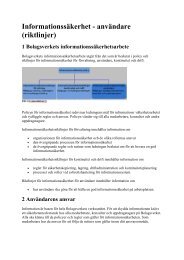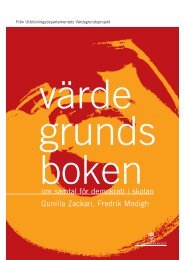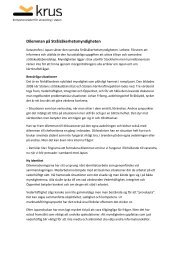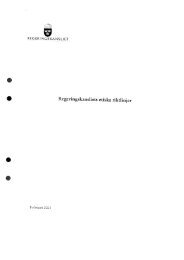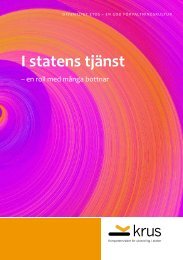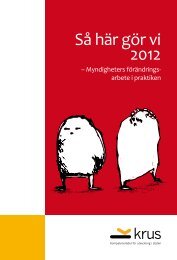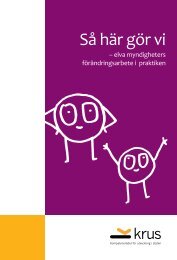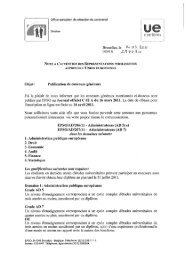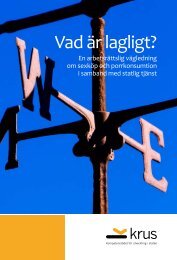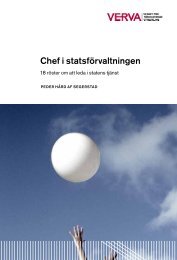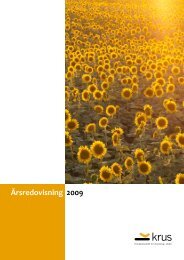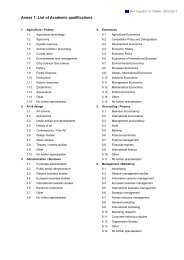Dialogkompetens i skolans vardag - Publikationer - LTU - Luleå ...
Dialogkompetens i skolans vardag - Publikationer - LTU - Luleå ...
Dialogkompetens i skolans vardag - Publikationer - LTU - Luleå ...
Create successful ePaper yourself
Turn your PDF publications into a flip-book with our unique Google optimized e-Paper software.
Listening Environment in School 17<br />
equipment instead of just their individual hearing aid. In several evaluation<br />
reports describing how to create prerequisite conditions for learning<br />
dialogues, teachers appear to have as their starting point the need to plan<br />
for all pupils to have access to the hearing loop (see www.dialogprojektet.se).<br />
When pupils themselves can try out different possibilities and can make<br />
choices that best suit their own particular experienced hearing loss, it is also<br />
positive for their self-image. Older students provide many statements<br />
concerning increased options for being flexible and not being limited because<br />
of the hearing loss and the use of a hearing loop (Wennergren 2004). In a<br />
similar vein Odelius and Johansson (2007) found in a study of 15 pupils that<br />
pupils had a strong preference for the m-setting on the hearing aid. As the<br />
amount of explanations show, it also demands a higher degree of consciousness<br />
and more detailed knowledge about individual needs connected to the<br />
hearing loss. Since classroom communication has, traditionally, meant<br />
listening via the hearing loop, the needs for listening in other circumstances<br />
may not have been seen as valuable knowledge in school. On the other hand,<br />
communicative situations outside school are mostly managed using an m-<br />
setting on the hearing aid and this provides an important argument for<br />
learning how to handle different communication situations.<br />
The study has shown that there are older pupils who do not accept their<br />
hearing loss, and even if that is not surprising, this is harder to explain<br />
when bearing in mind that the norm in the social practices focused upon<br />
in the study is that pupils are in need of technical equipment. It might be<br />
a signal of power, i.e. the norm in society is more powerful than the norm<br />
in school. Pupils in this context are continually going back and forth<br />
between the norm in school and the norm in wider society. If it is difficult<br />
openly to communicate different needs in school this might imply that it is<br />
equally difficult to communicate in practices outside school. On the basis<br />
of this result, it would be valuable for the culture of each school if<br />
teachers and headteachers discuss ways in which change towards a more<br />
open-minded attitude could be achieved. Why not, for example, let pupils<br />
systematically act as resources for communicating different listening<br />
strategies, since all of the pupils find themselves in a similar situation?<br />
Such a strategy would provide a unique educational opportunity for peer<br />
learning (see Williams 2001) as all pupils have an abundance of experiences<br />
of successful and less successful strategies, if only they are asked to<br />
describe them.<br />
None of the strategies mentioned by pupils in this study are by any means<br />
new to professionals working with rehabilitation (Gullacksen 2002). The<br />
development and learning of new strategies is contextually situated and<br />
therefore hard to prepare. Teachers’ attitudes and perspectives are important<br />
factors since it is important that they do not usurp the pupils’ own<br />
responsibility. It does not support the individual if the teacher is the only<br />
person who can control the different prerequisites for pupils who assume the<br />
role of listeners.<br />
According to Atterström (1995), dialogue competence for people with<br />
different kinds of communicative difficulties can be regarded as role



